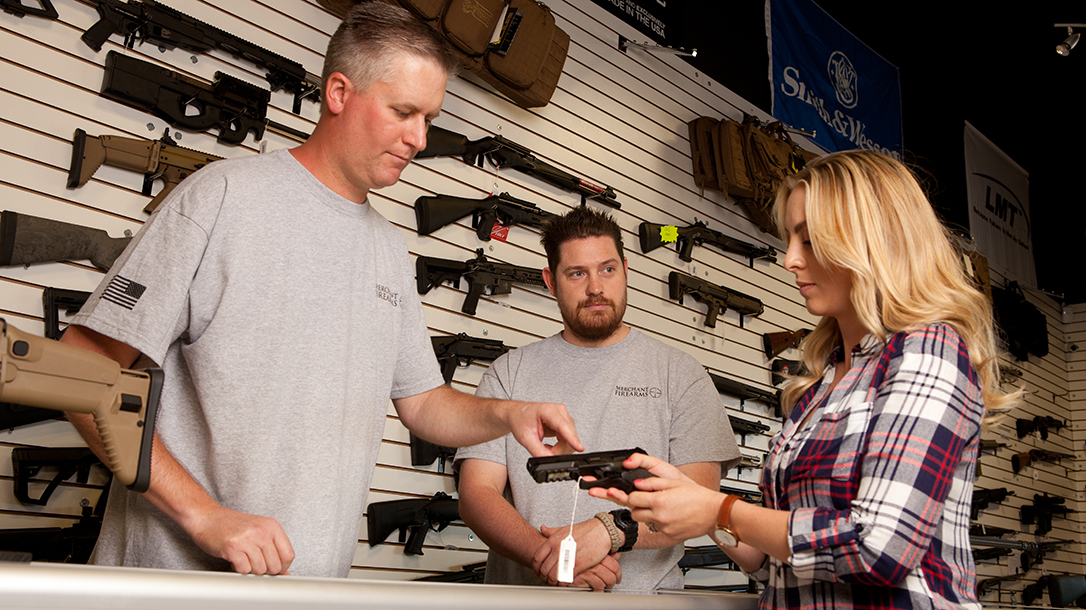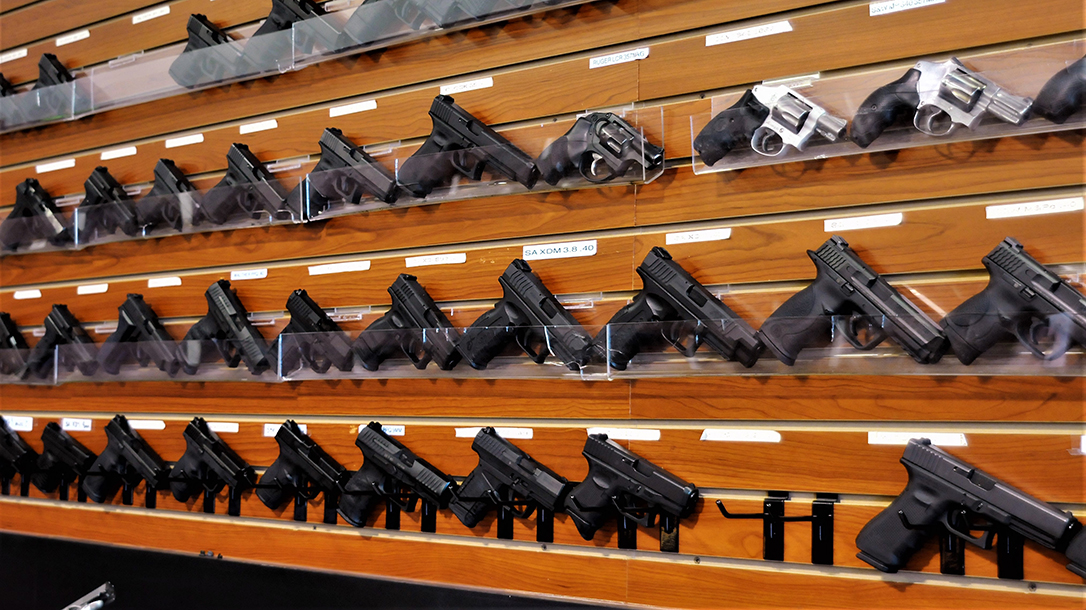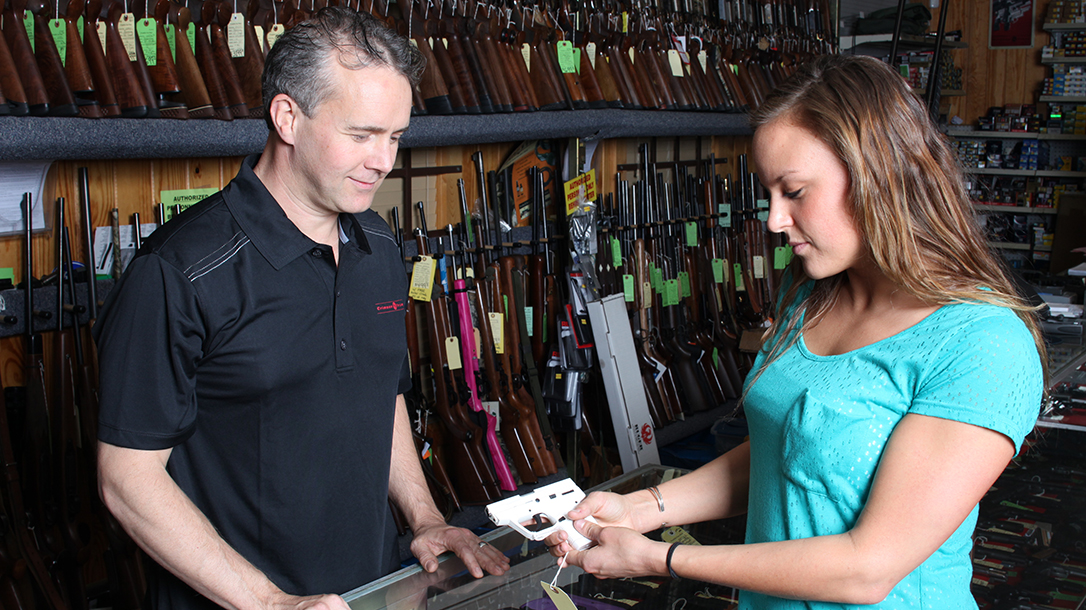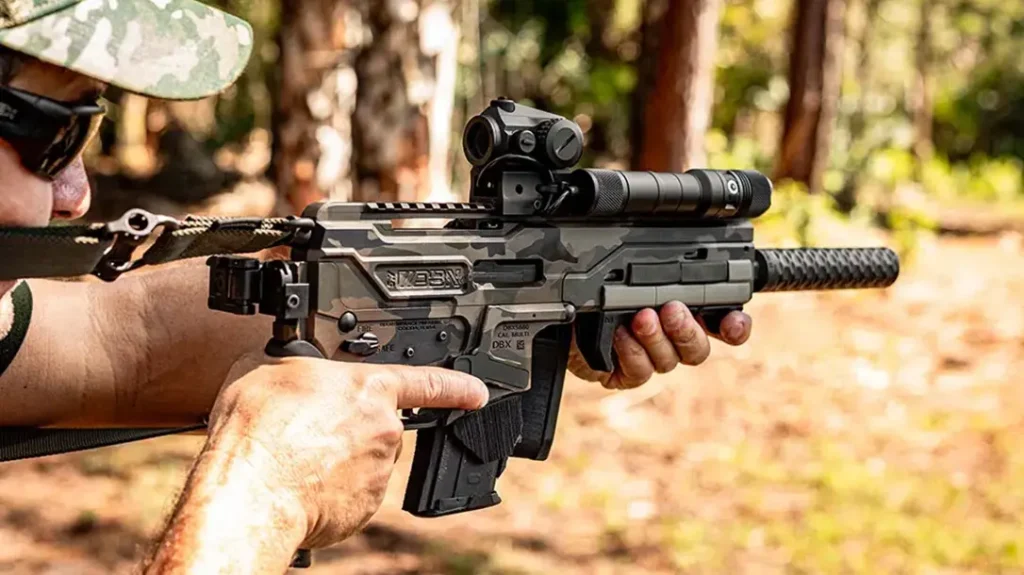You’ve done your homework. You’ve surfed the web, read magazines and asked friends for advice. You’re ready to purchase your first gun. Now what?
It’s time to take the next logical step and make a few trips to some local gun store. Here’s some advice to make the experience less intimidating and give you an idea of what to expect.
Advertisement — Continue Reading Below
The Visit to a Gun Store
I’ve shopped in countless gun shops from coast to coast, ranging from sleepy little stores with a dozen rifles, shotguns and pistols on display, to outfits with more than 1,000 guns in gleaming glass cases and racks that seemed to go on forever. A big gun store with a lot of traffic can be a great place to shop, but the selection can be mind-boggling. These big shops are the best places for novices to visit, though.
Let’s assume you’re going alone instead of with an experienced friend. You walk through the door and might be greeted by several signs from famous gun manufacturers, and a sign that says something like “No loaded guns on the premises” or “Any loaded guns must stay holstered at all times.” Basically, the gun store owner wants a safe environment where customers can comfortably and safely handle merchandise. Shop owners don’t want customers who have concealed-carry permits to handle loaded weapons in an unsafe manner among a shop full of patrons.
In better shops, you’ll quickly be greeted by a smiling salesperson. My advice is to first tell them you’re just browsing. Take some time to look around the shop to get a feel for what’s available. After making some mental notes about various products, walk to the glass cases and check them out. If you see someone talking to a salesperson and looking at a handgun, pretend you’re looking at something nearby and eavesdrop. You can learn a lot by listening to someone else who might be in a similar situation. You never know what you’ll learn as you listen to other customers and the salespeople working with them.
Advertisement — Continue Reading Below
Compare & Compare
Now it’s time to do some comparison shopping, and I don’t mean pricewise. When you have picked out the salesperson you want to work with (if there’s more than one), let them know you need help. If you’re in the market for a pistol for personal protection, let the salesperson know that—if they haven’t already asked. One of the first questions a salesperson should ask is whether you have or will soon receive a concealed-carry or CCW permit. This will help them narrow the selection. If you aren’t going to lug the pistol in a holster on your belt or in a bag, weight isn’t as much of a factor. If the pistol you seek will be stowed in a bedside table, it won’t matter as much if it’s heavier. Weight and size make a difference if you plan to carry the gun every day.
This might be your first gun purchase, but it might not be the first time you have handled a pistol. Remember, the salespeople will know gun-handling safety rules backwards and forwards, as do many of the store’s patrons. When the salesperson hands you a gun, pay close attention to where you point it. Experienced shooters really hate having a gun—even an unloaded gun in a shop—pointed directly at them. So, in terms of etiquette, I guess you could say it’s rude to point a gun at someone else. If the salesperson doesn’t show you that the gun is unloaded before handing it to you, double-check it yourself. Keep your finger off the trigger until you verify that the gun is unloaded. If you’re uncertain about something, don’t be afraid to ask.
Finding The Right Fit
As you handle various pistols, you’ll notice that many feel different. When you’re testing out the fit and feel of a pistol, form a “V” with your thumb and fingers, and press the pistol’s grip deeply into the notch that is formed. Grip the pistol as high as possible to the centerline of the barrel. Grip it firmly. You will notice that various grip panel styles feel sharp and edgy or smooth. Pick the one you’re most comfortable with, and try several of that style.
Advertisement — Continue Reading Below
Ask the salesperson if it’s okay to dry-fire the pistol; he’ll typically say yes. If it’s a semi-auto, draw the slide back fully, and if it locks back on the empty magazine, use the slide-release lever to let it slide back into battery. Sometimes you will need to use both hands to activate the slide release. Release the safety while pointing the gun toward the floor, and gently press the trigger until you hear the audible click or see the hammer fall. Do it again. You will notice that some pistols take more trigger-finger strength to fire than others. Make a mental note of what feels the most comfortable.
When you test a revolver, rest it on its side in the palm of your non-dominant hand. Push or pull the cylinder release with your trigger hand while using the middle finger of your non-dominant hand to gently push the cylinder open. Visually check to see that it’s empty, and then close it. Cock the hammer, and feel the amount of pressure it takes to drop the hammer. Then, pull the trigger again in double-action (without cocking the hammer first) to get a feel for how much more pressure it takes for the hammer to fall.
Advertisement — Continue Reading Below
Make it a goal to try at least a dozen pistols. Twice that isn’t excessive. Take the time to discuss caliber choices. The most popular caliber for self-defense pistols nowadays is the 9mm.
Revolvers & Semi-Autos
When a double-action revolver is loaded, it takes the least amount of motor skills and coordination to fire. Just point, squeeze and fire. In a deadly high-stress situation, this can be a game-changer that could tilt the odds in your favor. Some of the most popular lightweight, short-barreled revolvers only hold five rounds, and the standard is six rounds. It can take a few moments to reload, and that can be difficult in stressful situations if you’re unfamiliar with the gun. Limited capacity is definitely a con here, too.
Semi-auto pistols are typically heavier than revolvers, but that extra weight brings some advantages. More weight means they are more manageable under recoil. Many common mid-sized semi-autos hold more ammo, too. There’s a good chance you can find a semi-auto that feels good with a cartridge capacity from 15 to 18 rounds. Some semi-auto pistols are quite small, too. A .380 ACP with a single-stack magazine holding six or seven rounds can be covered with an average-sized hand.
Advertisement — Continue Reading Below
Finally, keep some of these tips in mind, learn as you go and try to enjoy your first trip to the local gun shop. Hopefully it won’t be your last.


























